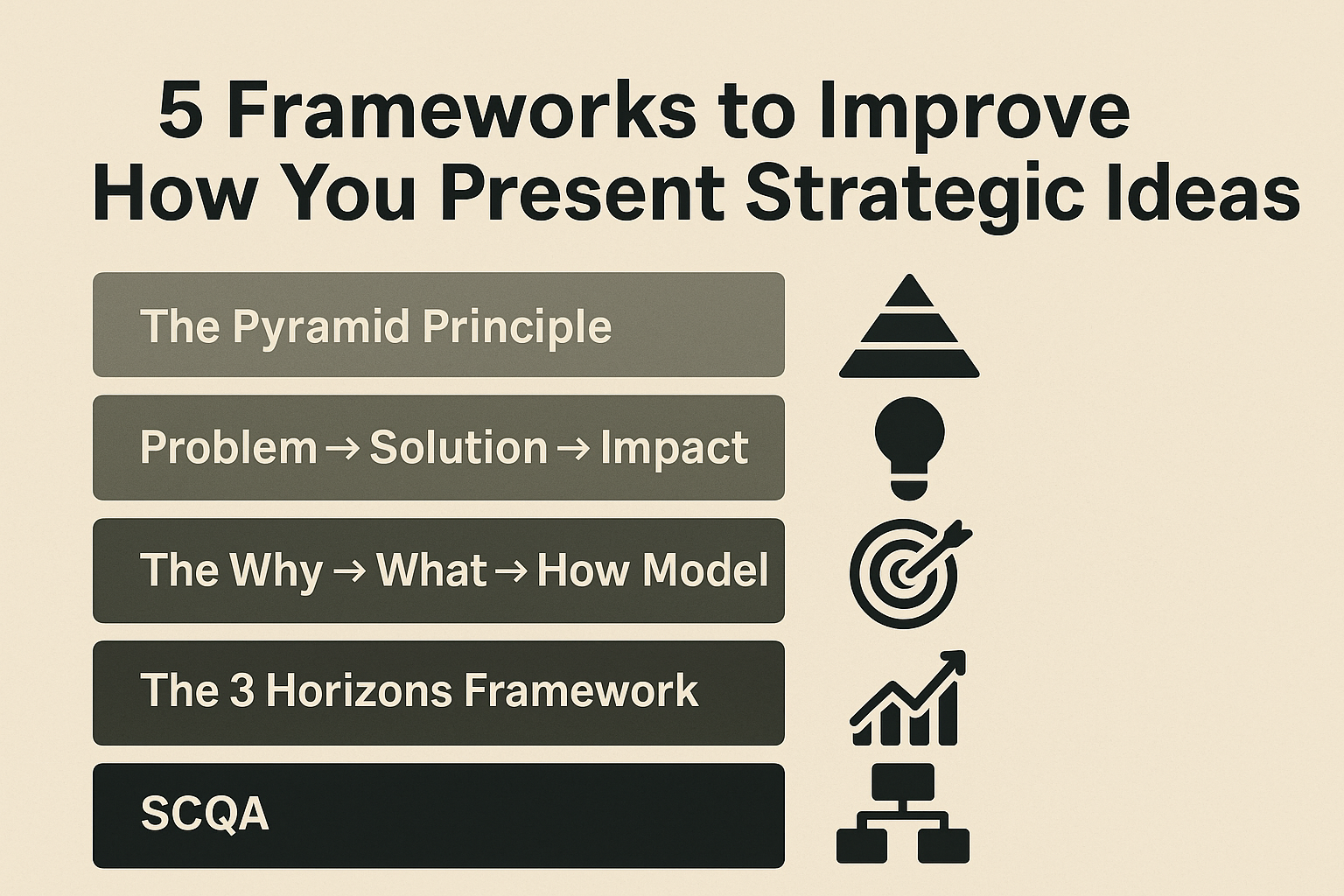5 Frameworks to Improve How You Present Strategic Ideas

Presenting a strategic idea is not just about having a good plan—it’s about delivering it in a way that clicks with your audience. Whether you're a founder pitching investors, a consultant aligning executives, or a product lead driving buy-in from stakeholders, the structure you use to present matters as much as the content itself.
Great ideas often get ignored because they’re poorly presented. Meanwhile, average ideas, when delivered with clarity and persuasion, can move entire teams into action.
Here are five proven frameworks to help you present strategic ideas more effectively—and make sure your audience doesn’t just hear you, but remembers and acts on what you say.
1. The Pyramid Principle
Best For: Board presentations, strategic reviews, investor decks
This classic framework, popularized by McKinsey, is built on one simple rule: start with the answer first.
Instead of slowly leading to your point, the Pyramid Principle begins with your main recommendation or insight, then breaks it down into supporting arguments and data.
Structure:
Top: Main idea or recommendation
Middle: Key supporting arguments (3 is ideal)
Bottom: Evidence, data, and rationale
This approach works especially well when dealing with senior decision-makers who want the punchline up front. It’s also the foundation used by many top-tier pitch deck experts when structuring decks for fast comprehension.
2. Problem → Solution → Impact
Best For: Change management, product pitches, transformation strategies
This is a simple but powerful storytelling model:
Problem – What challenge or inefficiency exists?
Solution – What is the proposed idea or change?
Impact – What measurable result will this deliver?
People are wired to respond to problems—especially if you can articulate them in a way that feels urgent. Use this framework to clearly show the gap, your fix, and the upside of taking action.
Pro tip: Include before/after visuals or data comparisons to make the “impact” section land harder.\
3. The Why → What → How Model
Best For: Vision casting, internal team briefings, innovation roadmaps
Simon Sinek made this structure famous with his “Start With Why” concept. The idea: you should begin by explaining why something matters—before getting into the what and how.
This order taps into emotion, purpose, and alignment before diving into execution. It’s especially effective when trying to get buy-in for a bold new direction or when rallying teams behind a vision.
Example:
Why: “We need to rethink how we onboard customers—because churn is highest in the first 14 days.”
What: “We’re proposing a new guided onboarding system with live support touchpoints.”
How: “We’ll launch an MVP in 4 weeks and iterate based on NPS scores and drop-off rates.”
4. The 3 Horizons Framework
Best For: Growth strategies, product roadmaps, long-term vision decks
Originally created by McKinsey, this model helps you structure strategic plans over time by breaking them into three horizons:
Horizon 1: Core business optimization (0–12 months)
Horizon 2: Emerging growth areas (12–36 months)
Horizon 3: Future bets and innovations (3–5 years+)
It shows that you’re thinking both tactically and strategically—addressing the now, the next, and the later.
If you're pitching investors or aligning C-level stakeholders, this framework helps demonstrate range in your thinking: you're not just solving today’s problem, you’re building for the future.
5. SCQA (Situation, Complication, Question, Answer)
Best For: Executive briefings, change initiatives, project approvals
This storytelling structure is ideal when you need to build logical momentum before dropping your proposal.
Here’s how it works:
Situation: What’s happening now?
Complication: What’s not working or changing?
Question: What should we do about it?
Answer: Your recommendation or strategic idea.
SCQA is particularly effective when you're trying to guide a skeptical audience toward a decision—they’re taken through a journey where the conclusion feels obvious by the time you reach it.
It’s also a go-to method used by professional pitch deck designers who specialize in crafting persuasive investor narratives from raw ideas.
Tying It All Together: Clarity Wins
You don’t need to reinvent your message every time you present. You need to organize it better.
The right framework:
Keeps your thinking sharp
Helps your audience follow along
Makes your ideas more memorable and shareable
Whether you’re speaking in a boardroom or sending a deck to a potential partner, the way you package your strategy signals how solid your thinking really is.
And if you want to go the extra mile, collaborate with a pitch deck design agency that understands how to merge structure with visual impact. Great design doesn’t just make things pretty—it enhances how your message is absorbed.
Final Thought
Strategic ideas win not just because they’re good—but because they’re presented well.
Choose a framework based on your audience and goal. Then refine your message, cut the noise, and support your insights with sharp visuals and real-world context.
People don’t remember clutter. They remember clarity.
Note: IndiBlogHub features both user-submitted and editorial content. We do not verify third-party contributions. Read our Disclaimer and Privacy Policyfor details.







